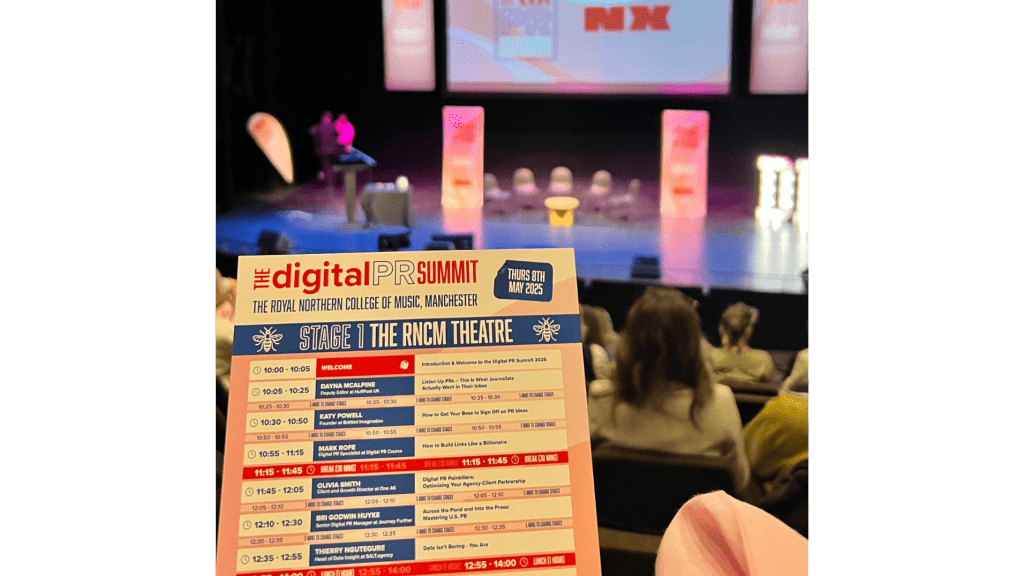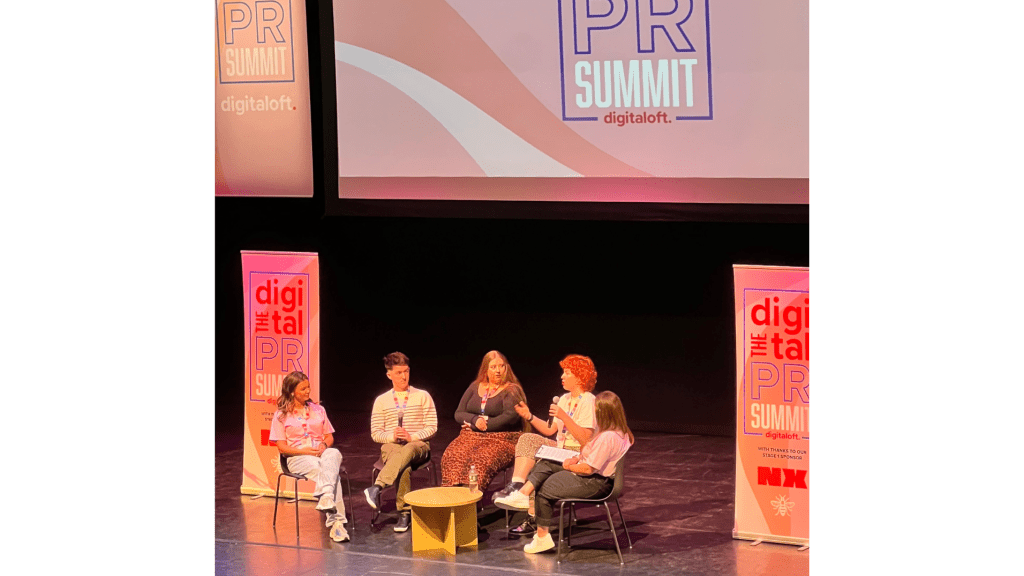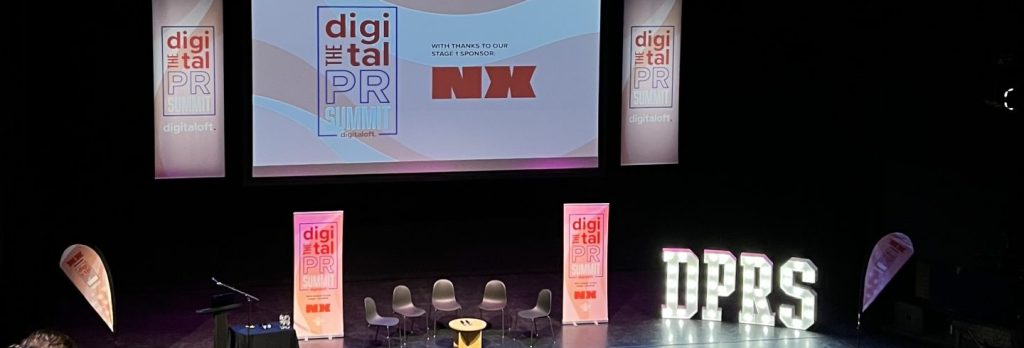Digital PR Summit 2025: Key Takeaways from KINESSO
KINESSO recently travelled to Manchester to attend Digitaloft’s Digital PR Summit 2025. Discover our key takeaways from the event.
Authored by Joel Lodge, Juliet Kabanetz and Amy Jones | 29th May 2025Earlier this month, KINESSO UK&I attended Digitaloft’s Digital PR Summit 2025. The event was packed with expert insights, practical takeaways, and honest conversations from leading voices in Digital PR and journalism. From refining how we pitch to understanding what really drives a successful campaign, every session delivered something valuable.
Highlights included Listen Up PR’s – This Is What Journalists Actually Want In Their Inbox from Dayna McAlpine – an honest discussion where Dayna told us what journalists are really looking for when filtering through their inboxes, and Afraid to Hit Send? Why Overthinking Is Killing Your Career (and How to Stop) from Kirsty Hulse – an empowering session on overcoming self-doubt.
Here are our top eight takeaways from the Digital PR Summit 2025:
1.Pitching to journalists has never been more nuanced.
It’s no industry secret that journalist’s inboxes are flooded with PR requests. HuffPost UK alone receives almost 70,000 emails a day. So, what can you do to stand out in such a crowded inbox?
According to Dayna McAlpine, Deputy Editor at HuffPost UK, the key is timing, clarity, and respect.
The very best outreach emails show you’ve researched the publication. Mirror the headline style in your subject line and only send the release if you’re sure it’ll work on their site. It’s important to avoid vague subject lines, AI-generated content, and buried brand mentions.
Timing is essential! Journalists prioritise the big stories early, so if your pitch isn’t newsworthy, hold off sending it until later in the day. Remember that real relationships with journalists win – keep it personal, but professional.
2. Google rewards brands, not links.
The way we measure PR success is changing. According to James Brockbank, Managing Director at Digitaloft, the goal of Digital PR should be visibility, reputation and business impact.
Links are a byproduct, not the end goal. While links have value, you should be tracking brand impact and focusing on building a brand that people want to visit. The brands that perform best on Google are those that people search for and trust – these are the big names they see everywhere.
When planning campaigns, consider if your PR activity will build brand reputation. Remember: links should be earned in the right way from the right places, to build a brand that deserves to win in search.

3. Don’t chase a link, earn a link.
Zoe Burke, Editor at Hitched, emphasised the importance of researching the publication you’re contacting. Does your pitch demonstrate you’ve read their content? According to Zoe, the anatomy of a good pitch includes a personalised subject line, credible data and a good understanding of the publication’s audience.
4. Search is constantly evolving.
During the journalist panel discussion, Dayna McAlpine (HuffPost), Danielle Wroe (Reach Plc), and Christopher Megrath (Liverpool Echo) highlighted how they’re witnessing search change. More recently, this is seen by the introduction of Google’s AI Overviews (AIOs). Nationals and news sites are losing traffic to AIOs as people searching on Google can get their answers immediately – they don’t need to search or read further.
5. Move beyond vanity metrics.
Millie White, Senior Digital PR Manager at Digitaloft, urged PRs to move beyond vanity metrics like link volume. Instead, focus on impact: keyword rankings, traffic attribution via GA4, and coverage that builds EEAT (Experience, Expertise, Authoritativeness, and Trust) signals. Relevance is everything – remember to link your success to wider business goals.
6. Cut the fluff and avoid a lawsuit.
Targeting the US market? The US is around 40 times larger than the UK, so it’s vital to focus on localisation – according to Bri Godwin Huyke, Senior Digital PR Manager at Journey Further.
Unlike the UK, where many will get their news from places like the BBC or Sky News, national sites like CNN, ABC or NBC aren’t the go-to sites for news for Americans. The American media is fragmented, and there are almost 8,000 local news outlets. This is where Americans rely on news which is local to them and likely to affect them.
The US media likes ‘boring’ headlines, they want them to be straightforward and factual. It’s important to cut the fluff and get to the point. They value credibility over clickbait and are significantly influenced by the issue of lawsuits and defamation if their claims aren’t true. US media as a result is data-driven, so when tackling the media across the pond, simple data which is regionally representative wins.

7. Even the best PR ideas need a smart internal sell.
Katy Powell, Founder of Bottled Imagination, reminded us that even the best PR ideas need a smart internal sell. Avoid rambling – use data, headlines, and relevance to win sign-off. Remember that it’s not just what you pitch to journalists, it’s how you pitch it internally that counts.
8. Digital PR can influence brand visibility in AI search.
Charlie Clark, Founder at Minty Digital, started his talk by sharing some insights into AI and the travel industry:
- 1 in 5 travellers uses AI search for trip planning
- 52% of US adults now use AI large language models like ChatGPT
- 27% of consumers now use Gen AI for at least 50% of their internet searches.
Charlie went on to explore the connection between Digital PR and AI search. Like traditional search engines, AI search perceives brands as entities – and PR-led brand building strengthens entity recognition. He also demonstrated the importance of authoritative publication citations and links, social citations and topical authority and relevancy in ranking for AI search.
Final Thoughts
Each session was equally valuable with expert knowledge ranging from crafting the perfect pitch to refocusing on which metrics really matter. Across the day there were some common themes, including:
- PR and journalist relations will continue to be important – and trust, responsiveness and consistent value help to build strong relationships.
- There needs to be an industry refocus on metrics that show business impact.
- AI is reshaping search – citations and mentions matter now more than ever.
Overall, the event was full of insightful talks delivered by industry experts and journalists from top publications. We came away with a host of invaluable takeaways, ideas, and learnings, which we’re excited to bring back to our teams and apply to our day-to-day work.
